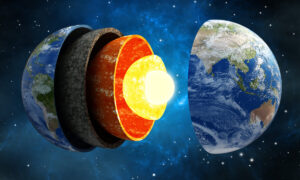You may be familiar with the “arrow of time,” but did you know there could be a second one?
Dr. Robert Hazen, a research associate at Carnegie Science’s Earth and Planetary Laboratory in Washington, D.C., thinks an arrow of time may be too restrictive. The second arrow, which he calls “the law of increasing functional information,” takes evolution into account. Specifically, Hazen explains that evolution seems to involve not only time, but also function and purpose.
Consider a coffee cup: it works best for holding your coffee, but it can also work as a paperweight, and it won’t work well at all as a screwdriver. Hazen explains that the universe seems to use a similar way to develop not only biology, but also other complex systems throughout the cosmos.
This idea suggests that as the universe ages and expands, it becomes increasingly organized and functional, almost the opposite of theories of increasing cosmological disorder. Hazen suggests that these two “arrows”—one of entropy and one of organized information—could very well run parallel to each other. If true, this theory could be groundbreaking in the way we perceive time, evolution, and the very fabric of reality.
Robert Hazen: I have a confession to make here. I have to be honest. We may be wrong. We could be spectacularly wrong. But it’s also possible that science is missing a profound truth about the cosmos. We have these 10 or more laws of nature, only one of which currently has an arrow of time. This is the second law of thermodynamics, the increase of entropy – this is disorder; it’s a breakdown.
We all age. We all die. But the second law does not explain why things develop; why life arises from non-life. You look around and see flowers blooming, trees blooming and birds singing. All these things seem to contradict the idea of disorder. In fact, this is a kind of arrangement of nature.
So let me tell you what we think: we think there is a missing law, a second arrow of time, that describes this increase in order, and we think it has to do with an increase in information. So there are two possibilities. We could just be wrong. We can be terribly, dramatically wrong. But I think if we’re wrong, we’re wrong in a very interesting way. And I think, if we’re right, that’s extremely important.
I’m Bob Hazen. I am a staff scientist at Carnegie Science’s Earth and Planetary Laboratory in Washington, DC. I am engaged in mineralogy, astrobiology. I love science. We think that for some reason a second arrow of time was missing. And this arrow is related to the increase of information, the increase of order, the increase of patterning, which goes hand in hand with the arrow of increasing disorder and increasing chaos, entropy.
At the core of everything we’ve thought about in terms of the missing law is evolution. When I say the word “evolution” you immediately think of Darwin, but this idea of selection goes far, far beyond Darwin and life. It refers to the evolution of atoms. It refers to the evolution of minerals. It applies to the evolution of planets, atmospheres and oceans. Evolution, which we see as an increase in diversity, patterning, complexity of systems over time.
So the question is, “Okay, what is evolution?” Evolution is simply selection for function. And that goes for any kind of system. Now, in life, you select organisms that can survive long enough to reproduce and have offspring that will pass on their characteristics. That’s what Darwin said, and it’s a very important example of selection for function. But in the world of minerals, you pick out organizations, assemblies, structures of atoms that persist, that can endure for billions of years even in new environments.
They don’t spoil. They do not dissolve. They do not weather. This is very analogous to biological evolution, but different in detail. We think there is a missing law – it is the law of evolution. And if there is a law, it must be quantitative. There should be an indicator. You need to be able to measure something. And what we’ve focused on is a fascinating concept about information, but not just information in general, something called “functional information.”
Let me see if I can explain this to you because it took me a while to figure it out. Imagine a system, an evolving system that has the potential to form a vast number of different configurations. Let’s say they are atoms to make minerals and you have dozens of different mineral-forming elements and they can arrange themselves in different ways. And 99.99999999—I could go on—percent of these configurations won’t work. They will fall apart. They will never form. A tiny, tiny fraction makes a stable mineral, and you end up with a few stable minerals and a lot of rejects.
Now all you have to do is think about that fraction. If one in a hundred trillion, trillion, trillion, trillion possibilities is stable, then you can represent that part as information. And because it’s such a small, small part, you need a lot of bits of information to do that—that’s functional information. Evolution is simply an increase in functional information, because as you select for better and better results, you select minerals that are more and more stable. You choose for living things that can swim. They can fly. They can see.
You need more information, and each step of the evolutionary ladder leads you to increase functional information. So our law, our missing law, the second arrow of time is called the Law of Increasing Functional Information. And that’s the parallel arrow of time that we think is out there somewhere that we want to understand. The idea of increasing functional information has a really deep meaning. Consider the functional information of a coffee mug; you may be holding one right now.
You have a bunch of atoms, and those atoms can be in trillions trillions trillion different configurations, but only a small fraction of those configurations will hold a cup of coffee. Now think of a coffee mug as a paperweight. I know you used a coffee cup as a paperweight. We all have and it’s pretty good, but you can make a better paperweight. And a coffee cup makes a terrible screwdriver. So think about it: We say that a coffee cup has value as a coffee cup. It has some value as a paperweight, but no value as a screwdriver – it’s contextual.
This is why the second arrow of time is difficult for science because it says that there is something in the natural world that is not absolute. It’s contextual. It depends on what your goal is. It depends on what your function is. If true, what we’re saying is that there’s something in the universe that increases order, increases complexity, and it doesn’t do so in a random way. Select for function. And if so, if you’re choosing for feature, that means there almost seems to be a — can I use the word “purpose?”
Do minerals have a purpose? Do atmospheres have a purpose? Does life have a purpose? To me there is something real there and the old way of thinking about a single arrow of time doesn’t ring true to me anymore.



